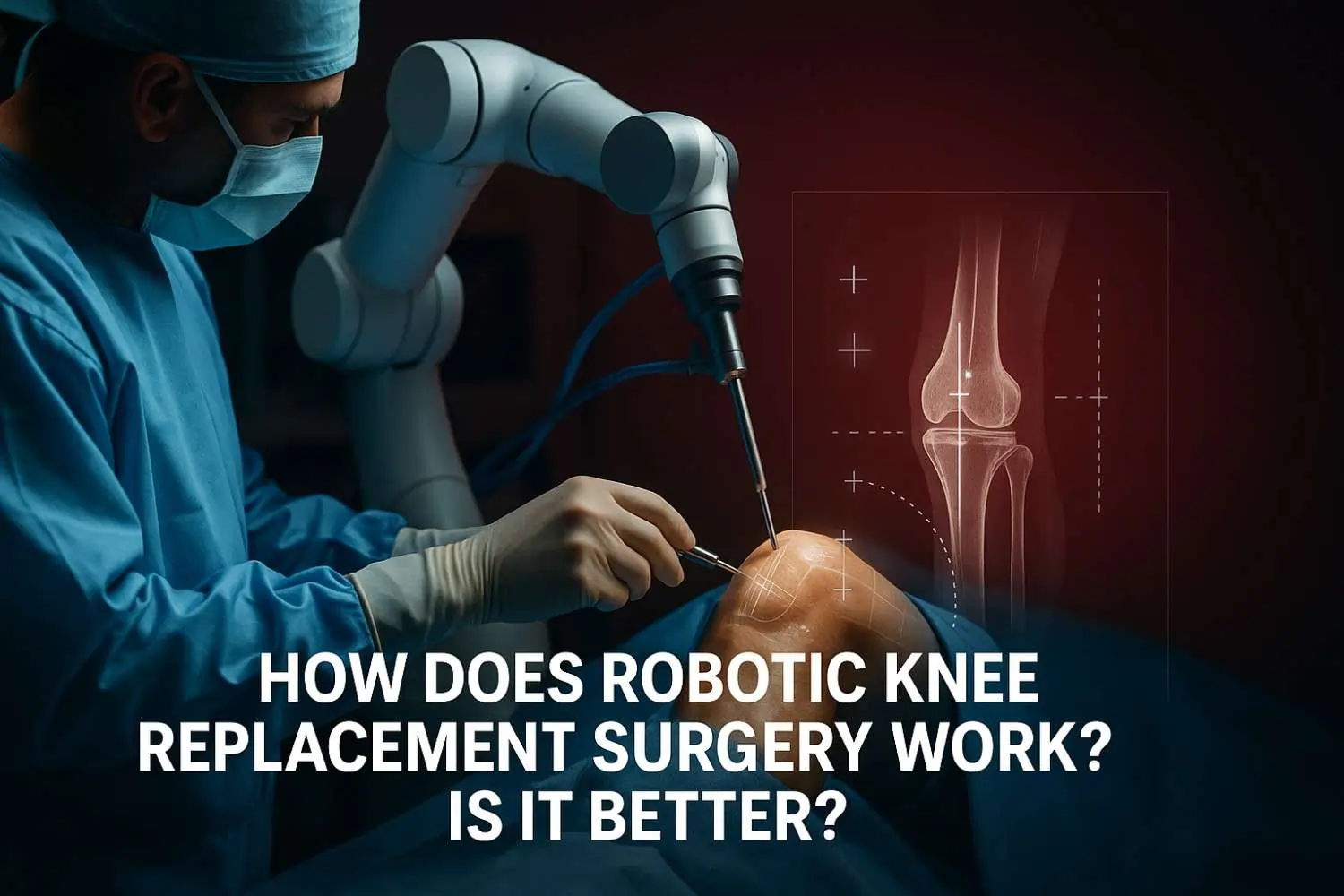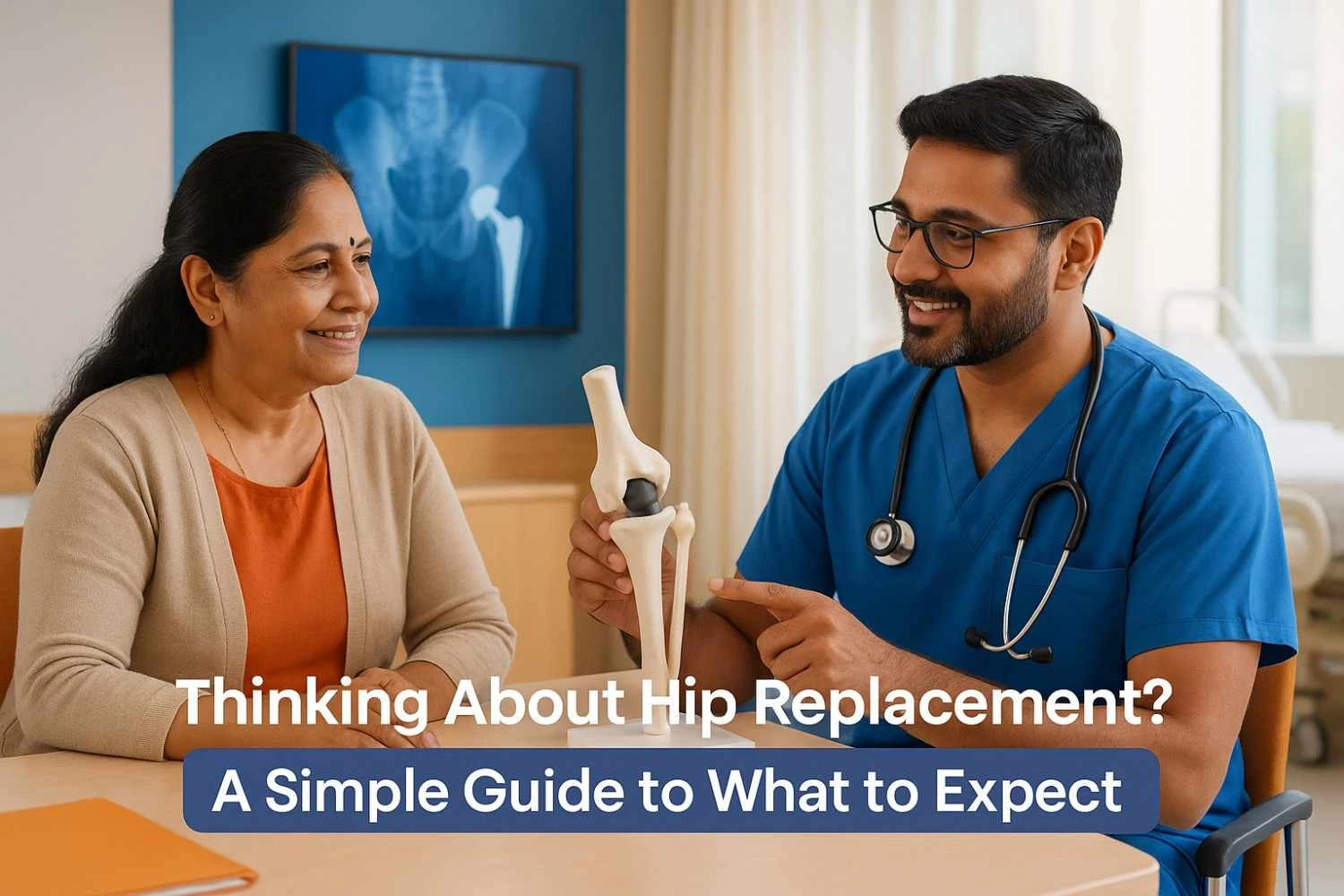Living with chronic knee pain can feel like a constant battle. Everyday activities like walking, climbing stairs, or even just standing up can become monumental tasks. In India, an estimated 15 crore people suffer from arthritis, with a significant portion facing limitations in their daily lives. For decades, total knee replacement has been a life-changing solution. But today, medical science offers an even more advanced option: Robotic Knee Replacement Surgery.
Robotic knee replacement surgery is an advanced procedure where an orthopaedic surgeon uses a robotic arm to perform the surgery with unparalleled precision. This technology enhances the surgeon's skill, allowing for a more accurate, customised, and minimally invasive knee replacement.
If you're considering this procedure, you likely have two big questions: How does it actually work? And is it truly better than the traditional method? At Germanten Hospitals, we believe in empowering our patients with clear, honest information. This comprehensive guide will walk you through everything you need to know about robotic knee replacement surgery in Hyderabad.
Understanding the Basics: What is Robotic Knee Replacement?
One of the biggest misconceptions about robotic surgery is that a robot is performing the operation on its own. This couldn't be further from the truth.
Think of the robotic system as an incredibly sophisticated and steady tool in the hands of your expert surgeon. The surgeon is in complete control at all times, guiding the robotic arm to execute a pre-determined surgical plan. The robot doesn't make decisions; it follows the surgeon's commands with a level of precision that is difficult to replicate by hand.
At Germanten Hospitals, we combine the world-renowned principles of German precision with the extensive experience of our surgical team. The robot enhances our ability to deliver a perfectly customised outcome for every single patient.
A Step-by-Step Look: How Does the Surgery Actually Work?
The process of a robotic knee replacement is a marvel of modern medicine, blending advanced imaging, intelligent software, and surgical expertise. It begins long before you enter the operating room.
Step 1: The Blueprint for a New Knee - Personalised 3D Planning
The journey starts with a detailed Computed Tomography (CT) scan of your leg, from your hip down to your ankle. This isn't just a standard X-ray. The CT scan provides hundreds of images that are used to create a dynamic, 3D virtual model of your unique knee anatomy.
This 3D model is the foundation for the entire procedure. Your orthopedic surgeon in Hyderabad can then perform a virtual "rehearsal" of your surgery. Using specialised software, they can:
- Select the Perfect Implant: Virtually test various implant sizes and shapes to find the one that is a perfect match for your bones.
- Plan Precise Cuts: Map out the exact amount of damaged bone to be removed, preserving as much healthy bone as possible.
- Optimise Alignment: Plan the ideal alignment of the implant to restore your leg's natural axis, which is crucial for the implant's long-term success and a natural feel.
This meticulous planning phase transforms the surgery from a reactive procedure into a proactive one, where potential challenges are solved before the first incision is even made.
Step 2: The Surgeon in Command - The Robot as a High-Tech Tool
Once the personalised 3D plan is loaded into the robotic system, the surgery begins. Your surgeon places small tracking pins into the thigh bone (femur) and shin bone (tibia). These pins are tracked by an infrared camera, allowing the system to know the exact position of your knee in space at all times.
The surgeon then guides the robotic arm, which holds the surgical instruments. The system provides real-time data and haptic feedback (tactile resistance), creating a virtual "safe zone" around the planned cutting area. If the surgeon's hand moves even a fraction of a millimetre outside the plan, the system will resist, preventing any damage to surrounding healthy bone, ligaments, and other soft tissues. The surgeon remains in 100% control, making micro-adjustments as needed based on the real-time feedback and their clinical judgment.
Step 3: Precision in Action - Executing the Surgical Plan
With the surgeon's guidance, the robotic arm precisely removes the damaged cartilage and bone, preparing the surfaces for the new implant. This is done with sub-millimetre accuracy, ensuring the implant will fit perfectly.
After the bone surfaces are prepared, the surgeon places the final implant components. They then test the knee's range of motion and stability to ensure a perfectly balanced and natural-feeling joint before closing the incision. This entire process ensures the digital plan is translated to your anatomy with a degree of accuracy that is simply unmatched.
The Big Question: Is Robotic Knee Replacement Really Better Than Traditional Surgery?
Traditional knee replacement is one of the most successful procedures in medical history. So, does adding a robot truly make a difference? The evidence points to a resounding "yes," especially in key areas that directly impact your recovery and long-term outcome.
The Unmatched Advantage: Surgical Precision and Customisation
In traditional surgery, surgeons use manual jigs and rods to guide their cuts. While effective in experienced hands, this method is less precise and subject to human variability.
Robotic surgery, however, consistently achieves superior alignment and implant placement. This incredible accuracy is not just about getting a "perfect X-ray." It translates into a knee that feels more natural, moves more smoothly, and is biomechanically balanced for your specific body.
Why Precision Matters: The Impact on Your Body and Recovery
The precision of robotics has a direct, positive impact on your body during surgery.
- Smaller Incisions: Robotic procedures are minimally invasive, often requiring an incision of just 4-6 inches, compared to 10-12 inches for traditional surgery.
- Less Tissue Damage: The robot's controlled movements and safety boundaries mean significantly less damage to the surrounding muscles, tendons, and ligaments.
- Reduced Pain and Blood Loss: Less trauma to the body naturally leads to less post-operative pain, swelling, and blood loss.
These short-term benefits create a domino effect for a better recovery. Patients who undergo robotic-assisted joint replacement in Hyderabad often experience:
- Shorter Hospital Stays: Many patients can go home in just 2-3 days.
- Faster Rehabilitation: Less pain allows you to start physical therapy sooner and regain mobility more quickly.
- Quicker Return to Normal Life: Patients often get back to their daily activities weeks earlier than with traditional surgery.
The Long Game: Does Robotic Surgery Mean the Implant Lasts Longer?
This is one of the most exciting potential benefits. The logic is simple: a more accurately aligned and balanced implant should experience less wear and tear over the years. This could significantly increase the lifespan of the implant, reducing the likelihood of needing a revision surgery in the future.
While robotic technology is relatively new, the long-term data is still being gathered. However, 10-year survival rates are already proven to be excellent. Most experts in the field agree that as we gather 15- and 20-year data, the superior durability of robotically placed implants will become even more evident.
A Clear Comparison: Robotic vs. Traditional Knee Replacement
To make it simple, here’s a head-to-head comparison of the two techniques.
| Feature | Robotic Knee Replacement | Traditional Knee Replacement |
|---|---|---|
| Surgical Planning | Personalised 3D model from a CT scan | Based on 2D X-rays and standard physical guides |
| Precision | Sub-millimetre, computer-guided accuracy | Relies on the surgeon's manual dexterity and eyesight |
| Incision Size | Smaller, minimally invasive (4-6 inches) | Larger (10-12 inches) |
| Soft Tissue Impact | Muscle-sparing with minimal disruption | Often requires cutting muscle/tendon for access |
| Recovery | Faster initial recovery, less pain, shorter hospital stay | Standard recovery timeline, typically longer hospital stay |
| Implant Longevity | Potentially longer due to superior alignment | Proven track record of 15-20 years |
| Best For | Complex cases, younger patients, and those seeking faster recovery | Standard, uncomplicated cases |
Who is the Right Candidate for Robotic Knee Replacement Surgery in Hyderabad?
Generally, if you are a good candidate for a traditional knee replacement, you are also a candidate for a robotic procedure. The primary criteria include:
- Severe, chronic knee pain that interferes with daily life.
- Significant stiffness, swelling, or instability in the knee.
- Failure of conservative treatments like medication, injections, and physical therapy to provide relief.
However, certain patients may benefit even more from the precision of robotics. This includes:
- Patients with Complex Deformities: Individuals with severe bow-legged or knock-kneed alignment can be challenging to correct manually. Robotics allows for precise correction.
- Patients with Previous Injuries: If you have old hardware (plates or screws) from a past fracture, robotics can plan the surgery around it, often avoiding a second surgery to remove the hardware.
- Younger, More Active Patients: For younger individuals, implant longevity is critical. The pinpoint accuracy of robotics is ideal for "cementless" implants, which are designed to fuse with the bone and may last longer, making it a great option for active patients.
The only way to know for sure is to have a thorough orthopaedic consultation in Hyderabad. An expert surgeon can evaluate your specific condition and recommend the best path forward.
Navigating the Practicalities: Cost and Insurance in India
What is the Cost of Robotic Knee Replacement Surgery in Hyderabad?
It's true that robotic surgery has a higher upfront cost than the traditional method. This is due to the significant investment in the technology and the specialised, single-use instruments required for each procedure.
In Hyderabad, the cost for a single robotic knee replacement typically ranges from ₹2,50,000 to ₹4,50,000.
While this is higher than traditional surgery, many see it as a better long-term investment. The potential for a longer-lasting implant (avoiding a costly revision surgery) and a faster recovery (quicker return to work) provides a significant return on investment.
Is Robotic Surgery Covered by Health Insurance in India?
Yes, in most cases. In 2019, the Insurance Regulatory and Development Authority of India (IRDAI) issued a directive mandating that health insurance companies must cover robotic surgeries under their "modern treatments" benefit.
This is great news for patients, but you must check the fine print of your policy for:
- Waiting Periods: Most policies have a 2 to 4-year waiting period for pre-existing conditions like osteoarthritis.
- Sub-limits: Many plans cap the amount they will pay for modern treatments. For example, they might only cover up to 50% of the sum insured or a fixed amount.
- Pre-authorization: It is crucial to get approval from your insurer before the surgery to ensure a smooth, cashless process.
Why Choose Germanten as the Best Knee Replacement Hospital in Hyderabad?
When it comes to your health, choosing the right hospital and surgeon is the most important decision you will make. At Germanten Hospitals, we have established ourselves as a premier orthopedic hospital in Hyderabad by building our practice on a foundation of excellence.
- German Precision & Technology: We are the first to bring German precision robotic technology for joint replacements to Telangana. Our commitment to international standards ensures you receive world-class care.
- Expert Surgeons: Technology is only as good as the person using it. Our team is led by Dr. Mir Jawad Zar Khan, a renowned knee replacement surgeon in Hyderabad with over 25 years of experience and more than 10,000 successful surgeries to his name.
- Advanced Robotic Systems: We are equipped with the latest, most advanced robotic platforms, ensuring you benefit from the very best technology available today.
- Patient-Centric Care: From your first consultation to your final rehabilitation session, our entire team is dedicated to providing compassionate, personalised care to help you achieve your goals. We are proud to be trusted by patients not just from Hyderabad, but from across India and the world.
The Final Takeaway: Is Robotic Knee Replacement the Right Choice for You?
The evidence is clear: robotic knee replacement offers proven advantages in surgical precision, which leads to a faster, less painful initial recovery and the potential for a longer-lasting, more natural-feeling knee.
However, the most critical factor in the success of any knee replacement remains the skill and experience of the surgeon. The robot is a powerful tool that, in the right hands, elevates a great surgeon's ability to deliver a truly exceptional outcome.
If you are tired of letting knee pain control your life, it's time to explore your options.
Ready to take the first step towards a pain-free future? Schedule an orthopaedic consultation in Hyderabad with our experts at Germanten Hospitals today. Let us help you determine if robotic-assisted joint replacement in Hyderabad is the right path to get you back to the life you love
Frequently Asked Questions (FAQs)
1. Does the robot perform the surgery by itself?
No. The robot is a highly
advanced tool that is 100% controlled and guided by your expert orthopedic surgeon throughout the
entire procedure.
2. Is robotic knee surgery more painful?
No, quite the opposite. Because it
is minimally invasive and spares more healthy tissue, patients generally report less pain and a more
comfortable initial recovery compared to traditional surgery.
3. How long will I be in the hospital?
The hospital stay is typically
shorter. Most patients are able to go home within 2 to 3 days of the surgery.
4. What are the risks involved?
The general risks (like infection or blood
clots) are similar to traditional surgery and are very low, occurring in less than 1-2% of patients.
There is a very small additional risk of complications related to the tracking pins used during the
procedure, such as a localized infection or fracture.




